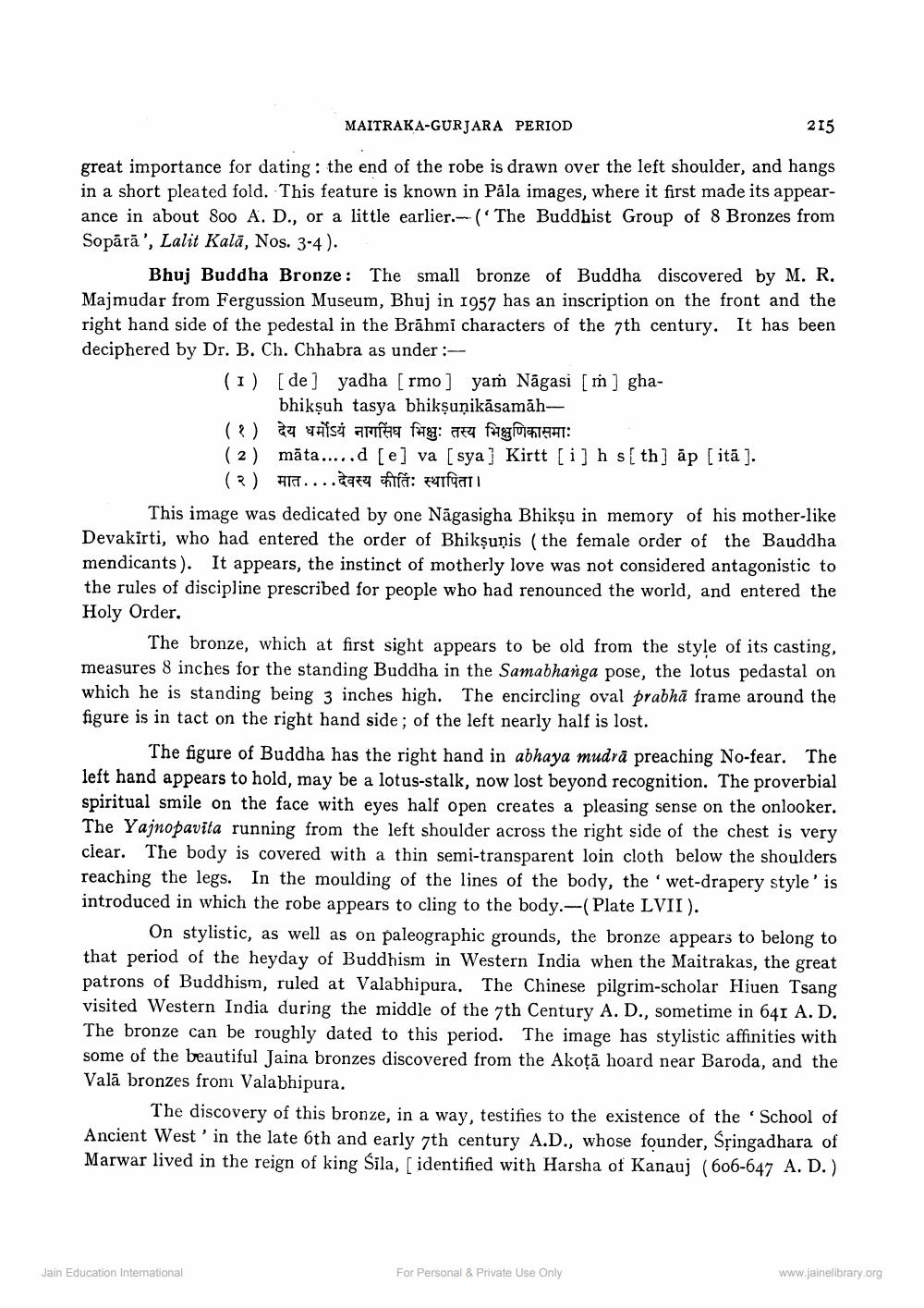________________
MAITRAKA-GURJARA PERIOD
215
great importance for dating : the end of the robe is drawn over the left shoulder, and hangs in a short pleated fold. This feature is known in Pāla images, where it first made its appearance in about 800 A. D., or a little earlier.-('The Buddhist Group of 8 Bronzes from Sopārā', Lalit Kalā, Nos. 3-4).
Bhuj Buddha Bronze: The small bronze of Buddha discovered by M. R. Majmudar from Fergussion Museum, Bhuj in 1957 has an inscription on the front and the right hand side of the pedestal in the Brāhmi characters of the 7th century. It has been deciphered by Dr. B. Ch. Chhabra as under :
(1) [de] yadha (rmo ] yaṁ Nāgasi ( m ) gha
bhikṣuh tasya bhikṣuṇikāsamāh(१) देय धर्मोऽयं नागसिंघ भिक्षुः तस्य भिक्षुणिकासमाः (2) māta.....d[e] va [sya] Kirtt [i] h s[th] ap (itā).
(2) ART. ...gara la: yrat This image was dedicated by one Nāgasigha Bhikṣu in memory of his mother-like Devakirti, who had entered the order of Bhikṣunis (the female order of the Bauddha mendicants). It appears, the instinct of motherly love was not considered antagonistic to the rules of discipline prescribed for people who had renounced the world, and entered the Holy Order.
The bronze, which at first sight appears to be old from the style of its casting, measures 8 inches for the standing Buddha in the Samabhanga pose, the lotus pedastal on which he is standing being 3 inches high. The encircling oval prabhā frame around the figure is in tact on the right hand side ; of the left nearly half is lost.
The figure of Buddha has the right hand in abhaya mudră preaching No-fear. The left hand appears to hold, may be a lotus-stalk, now lost beyond recognition. The proverbial spiritual smile on the face with eyes half open creates a pleasing sense on the onlooker. The Yajnopavita running from the left shoulder across the right side of the chest is very clear. The body is covered with a thin semi-transparent loin cloth below the shoulders reaching the legs. In the moulding of the lines of the body, the 'wet-drapery style'is introduced in which the robe appears to cling to the body.--(Plate LVII).
On stylistic, as well as on paleographic grounds, the bronze appears to belong to that period of the heyday of Buddhism in Western India when the Maitrakas, the great patrons of Buddhism, ruled at Valabhipura. The Chinese pilgrim-scholar Hiuen Tsang visited Western India during the middle of the 7th Century A. D., sometime in 641 A. D. The bronze can be roughly dated to this period. The image has stylistic affinities with some of the beautiful Jaina bronzes discovered from the Akoţā hoard near Baroda, and the Valā bronzes from Valabhipura.
The discovery of this bronze, in a way, testifies to the existence of the School of Ancient West' in the late 6th and early 7th century A.D., whose founder, Spingadhara of Marwar lived in the reign of king sila, [identified with Harsha of Kanauj (606-647 A. D.)
Jain Education Interational
For Personal & Private Use Only
www.jainelibrary.org




